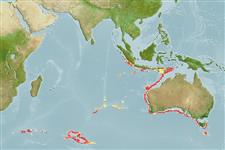Classification / Names
Nomi Comuni | Sinonimi | Catalog of Fishes (gen., sp.) | ITIS | CoL | WoRMS | Cloffa
Elasmobranchi (squali e razze) (sharks and rays) >
Rajiformes (Skates and rays) >
Arhynchobatidae (Skates)
Etymology: Notoraja: Greek, noton = back + Latin, raja = fish, Raja sp. (Ref. 45335); sticta: Name from Greek 'stiktos' meaning spotted or dappled, refers to its strong blotched dorsal coloration.. More on author: Last.
Ambiente / Clima / Range
Ecologia
; marino batidemersale; distribuzione batimetrica 820 - 1200 m (Ref. 75642). Temperate, preferred ?
Eastern Indian Ocean: South Australia.
Size / Peso / Age
Maturity: Lm ? range ? - ? cm
Max length : 62.7 cm TL maschio/sesso non determinato; (Ref. 75642)
Length of this species reaches at least 62.7 cm TL; adult males 52.5-54.3 cm TL, a juvenile male paratype at 50.8 cm TL, the smallest specimen was 27.1 cm TL (Ref. 75642).
Life cycle and mating behavior
Maturità | Riproduzione | Deposizione | Uova | Fecundity | Larve
McEachran, J.D. and P.R. Last, 2008. New deepwater skates of the genus Notoraja (Rajoidei: Aehynchobatidae) from southern Australia and the eastern Indian Ocean. In Last, P.R., W.T. White, J.J. Pogonoski and D.C. Gledhill (eds): Descriptions of new Australian skates (Batoidea: Rajoidei) Pg. 155-172. CSIRO marine and atmospheric research paper no. 021. (Ref. 75642)
IUCN Red List Status (Ref. 115185)
CITES (Ref. 94142)
Not Evaluated
Threat to humans
Harmless
Human uses
Informazioni ulteriori
Nomi ComuniSinonimiMetabolismoPredatoriEcotossicologiaRiproduzioneMaturitàDeposizioneFecundityUovaEgg development
Age/Size
Accrescimento
Length-weight
Length-length
Length-frequencies
Morfometria
Morfologia
Larve
Dinamica popolazioni larvali
Reclutamento
Abbondanza
BibliografiaAcquacolturaProfilo di acquacolturaVarietàGeneticaFrequenze allelicheEreditarietàMalattieElaborazioneMass conversion
CollaboratoriImmaginiStamps, CoinsSuoniCiguateraVelocitàModalità di nuotoArea branchialeOtolithsCervelliVista
Strumenti
Special reports
Download XML
Fonti Internet
Estimates of some properties based on models
Phylogenetic diversity index (Ref.
82805): PD
50 = 0.5005 [Uniqueness, from 0.5 = low to 2.0 = high].
Bayesian length-weight: a=0.00513 (0.00253 - 0.01042), b=3.12 (2.95 - 3.29), in cm Total Length, based on LWR estimates for this (Sub)family-body shape (Ref.
93245).
Trophic Level (Ref.
69278): 3.8 ±0.7 se; Based on size and trophs of closest relatives
Resilienza (Ref.
69278): Basso, tempo minimo di raddoppiamento della popolazione 4.5 - 14 anni (Preliminary K or Fecundity.).
Vulnerability (Ref.
59153): High vulnerability (58 of 100) .
